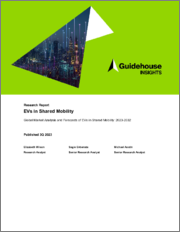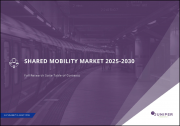
|
시장보고서
상품코드
1345884
공유 모빌리티용 전기자동차(EV) : 공유 모빌리티용 전기자동차(EV)의 세계 시장 분석 및 예측(2023-2032년)EVs in Shared Mobility: Global Market Analysis and Forecasts of EVs in Shared Mobility, 2023-2032 |
||||||
전기차(EV) 및 전기차 충전 인프라 시장은 정부의 규제와 인센티브, 환경, 사회, 기업지배구조(ESG)에 대한 관심에 힘입어 전 세계적으로 빠르게 성장하고 있습니다. 국가 차원의 노력과 더불어 인구 밀집 지역 지자체는 배기가스 감축을 위한 자체적인 법률을 제정하고 있습니다. 반면, 도시에서의 자동차 소유는 여전히 비싸고 비효율적이라는 문제가 있습니다. 도시 거주자들이 자동차 소유 비용의 상승, 이산화탄소 배출량, 저렴한 복합 교통수단에 대한 인식이 높아짐에 따라 개인 자동차 소유는 감소할 것으로 보입니다. 이러한 소비자들은 라이드 헤일링, 카셰어링 프로그램, 기업용 리스 등 공유 모빌리티를 통해 자동차에 대한 필요를 충족시킬 것으로 보입니다.
이러한 공유 모빌리티는 특정 지역의 모빌리티 서비스 업체를 대상으로 하는 법률과 함께 각 국가 및 지역별로 강화되고 있는 자동차 배출가스 규제를 준수해야 합니다. 경우에 따라 이러한 서비스를 이용하는 사람들은 저배출 솔루션을 원하고 있으며, 이에 따라 기업들은 보유 차량을 EV로 전환할 수 있는 기회를 찾게 됩니다. 공유 모빌리티 서비스 업체들은 OEM과 협력하여 운전자에게 전기차 및 충전 솔루션을 제공하거나 승객을 위한 전기차 전용 옵션을 개발하는 경우가 늘고 있습니다.
이 보고서는 공유 모빌리티 서비스가 제공하는 내연기관차에서 전기차로의 전환을 촉진하는 요인(온실가스 배출 및 ESG 보고에 대한 정부 규제)과 억제하는 요인(차량 조달 비용 및 가용성, 충전 인프라의 한계, 소비자의 가격 민감도)에 주목하며, 공유 모빌리티 서비스가 제공하는 내연기관차에서 전기차로의 전환을 검토합니다. 정부의 보조금 제도와 규제가 지속되고, 공유 모빌리티 플랫폼과 충전소 사업자의 파트너십이 지속되며, 도시 지역에서 공유 모빌리티 서비스에 대한 소비자 수요가 개인 차량 보유를 넘어선다면, 공유 모빌리티에서 EV는 예측 기간 동안 성장할 수 있는 충분한 기회를 가질 수 있습니다.
목차
제1장 주요 요약
제2장 시장 문제
- 시장 내역
- 라이드 헤일링
- 카셰어링 프로그램
- 법인용 리스
- 기술 내역
- 배터리식 전기자동차
- 플러그인 하이브리드 자동차
- 시장 성장 촉진요인
- 정부의 온실가스 배출 규제
- 기업의 ESG에 대한 우려
- 시장 장벽
- 차량 조달 비용과 입수 가능성
- 충전 인프라
- 소비자의 가격 민감도
- 가격 수준
- 소비자용 가격 수준
- 플릿 취득 가격 수준
제3장 업계의 밸류체인
- 경쟁 상황
- 비지니스 모델의 진화
제4장 시장 예측
- 서론
- 범위와 조사 방법
- 주요 가정
- 차량 판매와 재고
- 매출
제5장 결론과 제안
- 3개 주요 사항
- 제안
- 도시 행정에 대한 제안
- 공유 모빌리티 서비스 플랫폼에 대한 제안
- 충전 서비스에 대한 제안
제6장 두문자어 및 약어 리스트
제7장 목차
제8장 도표
제9장 분석 범위, 정보 출처, 분석 방법, 주석
ksm 23.09.26The EV and corresponding EV charging infrastructure market, buoyed by government regulations and incentives and environmental, social, and corporate governance (ESG) concerns, is rapidly growing around the world. Along with national government initiatives, municipal governments in densely populated areas are instituting their own laws to cut down on tailpipe emissions. Meanwhile, car ownership in urban areas continues to be costly and inefficient. Individual car ownership is likely to decrease as city dwellers become more aware of rising ownership costs, their carbon footprints, and less costly multimodal transportation options. These consumers will likely look to shared mobility vehicles to meet their car needs-including ride-hailing, carshare programs, and corporate leasing.
These shared mobility vehicles will be required to follow increasingly stringent national and subnational regulations for vehicle emissions, along with laws specifically aimed at mobility services companies in certain regions. In some cases, those using these services will look for low emissions solutions, which will prompt companies to look for opportunities to transition their fleets to EVs. Increasingly, shared mobility services are partnering with OEMs to provide drivers with ready EVs and charging solutions and are developing EV-specific options for riders.
This report examines the transition of shared mobility services offerings from internal combustion engine (ICE) powered vehicles to EVs, with attention to market drivers (government regulations for greenhouse gas emissions and ESG reporting) and barriers (cost and availability of vehicle procurement, charging infrastructure limitations, and consumer price sensitivity). EVs in shared mobility have ample opportunity to grow over forecast period, provided that governments continue their subsidy programs and regulation, partnerships continue between shared mobility platforms and charge point operators, and consumer demand for shared mobility services exceeds individual car ownership in urban areas.
Table of Contents
1. Executive Summary
- 1.1 Introduction
- 1.2 Scope
- 1.3 Market Forecast
2. Market Issues
- 2.1 Market Segmentations
- 2.1.1 Ride-Hailing
- 2.1.2 Carshare Programs
- 2.1.3 Corporate Leasing
- 2.2 Technology Segmentations
- 2.2.1 Battery Electric Vehicles
- 2.2.2 Plug-In Hybrid Electric Vehicles
- 2.3 Market Drivers
- 2.3.1 Government Greenhouse Gas Emissions Regulations
- 2.3.1.1 National Regulations and Incentives
- 2.3.1.2 Local Regulations and Incentives
- 2.3.2 Corporate ESG Concerns
- 2.3.1 Government Greenhouse Gas Emissions Regulations
- 2.4 Market Barriers
- 2.4.1 Cost and Availability of Vehicle Procurement
- 2.4.2 Charging Infrastructure
- 2.4.3 Consumer Price Sensitivity
- 2.5 Pricing
- 2.5.1 Pricing for Consumer Use
- 2.5.2 Pricing for Fleet Acquisition
3. Industry Value Chain
- 3.1 Competitive Landscape
- 3.1.1 Business Model Evolution
4. Market Forecasts
- 4.1 Introduction
- 4.2 Scope and Methodology
- 4.3 Key Assumptions
- 4.4 Vehicle Sales and Stock
4.5 Revenue
5. Conclusions and Recommendations
- 5.1 Three Big Takeaways
- 5.2 Recommendations
- 5.2.1 Recommendations for Urban Governments
- 5.2.2 Recommendations for Shared Mobility Services Platforms
- 5.2.3 Recommendations for Charging Services



















